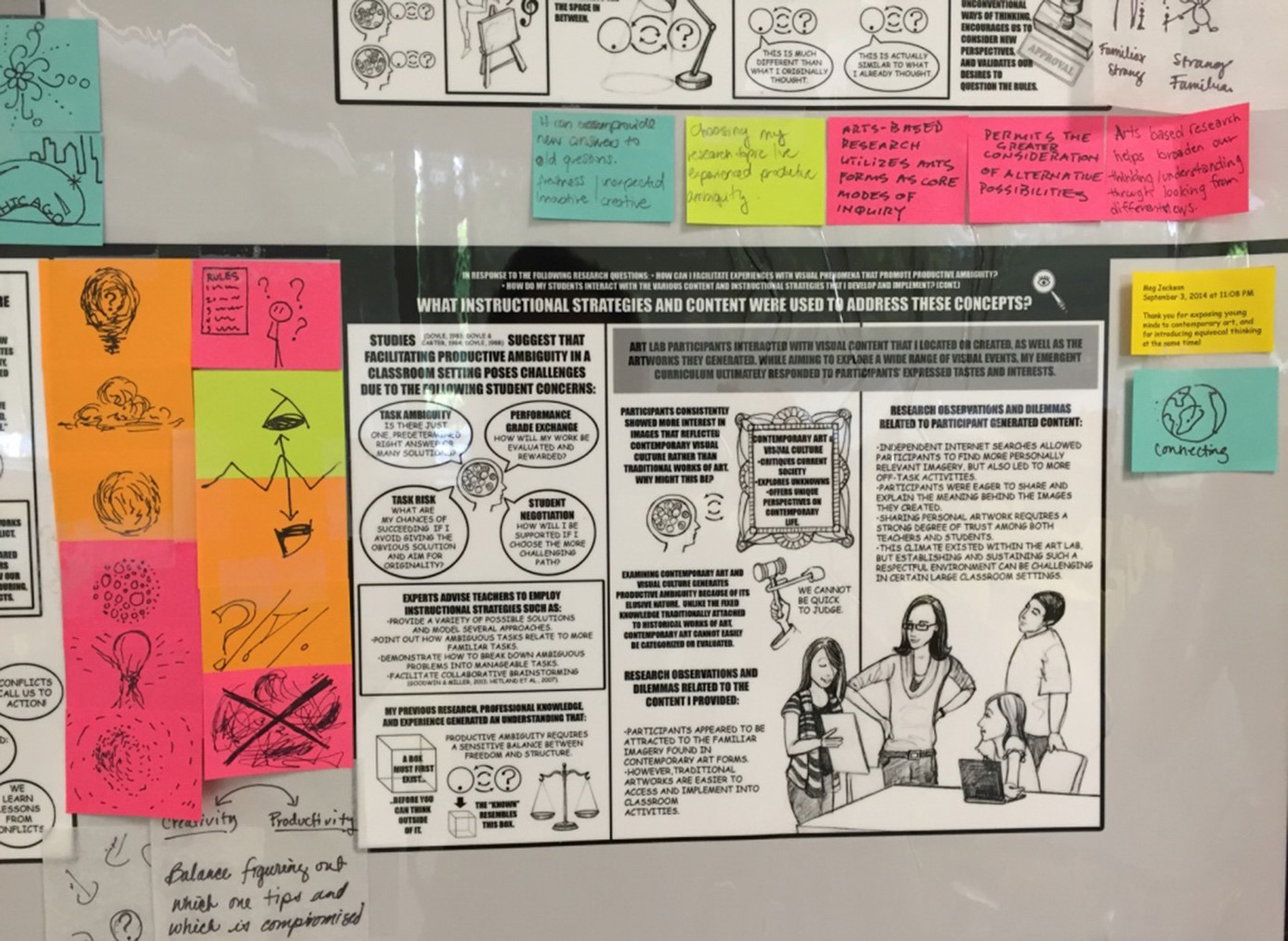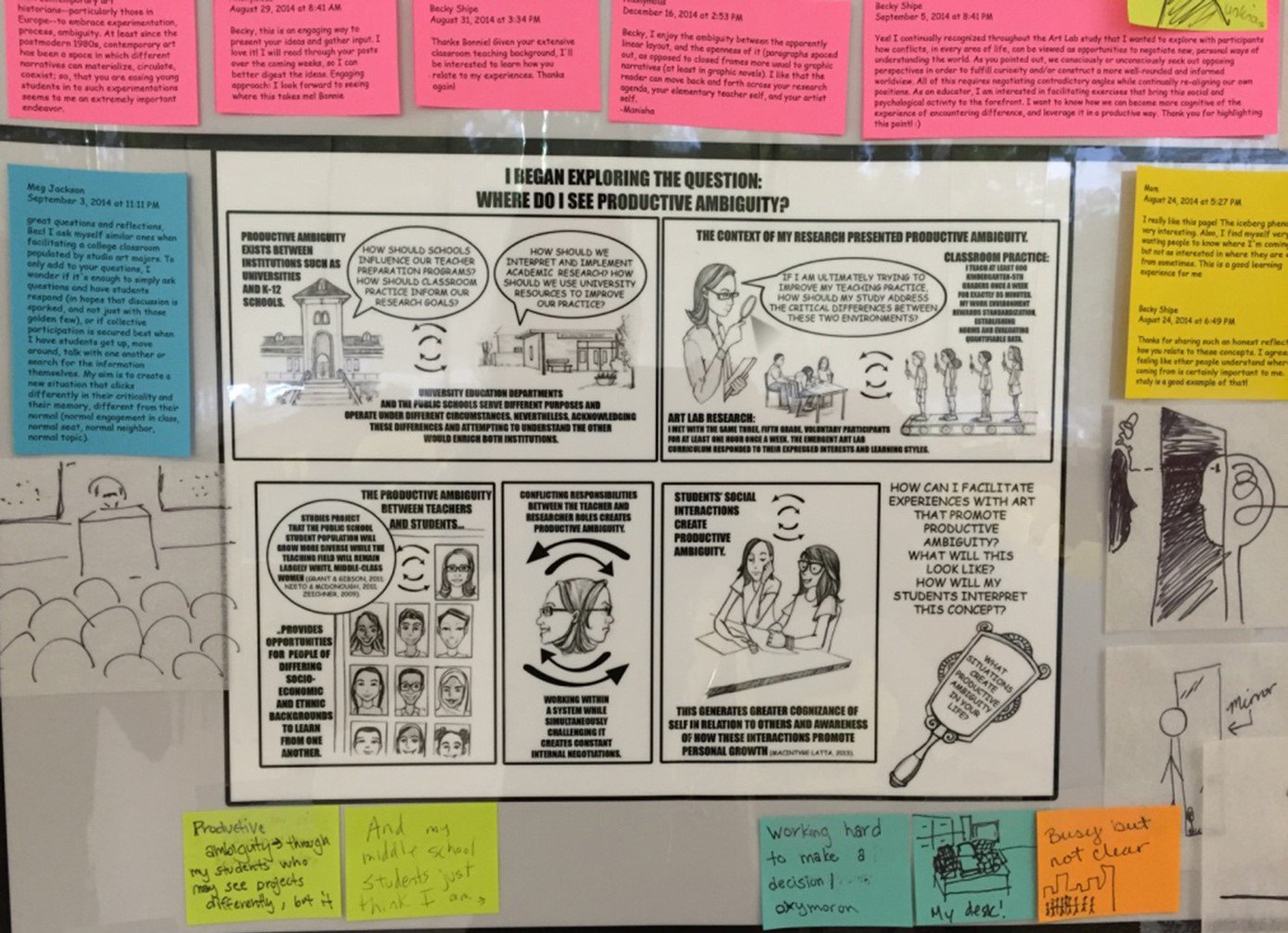- Introduction
- Interpreting a Seminar for Research and Curriculum Development in Art Education: Context and Significance
- Exploring Arts Based Research and Productive Ambiguity
- Emerging Art Education through Intra-Action within STEAM
- Searching for Openings: Institutional Politics and Feminist Pedagogy
- Living the Vision: A Seminar in Art Education for Research and Curriculum Development, 1965 to 2016
- The Art Education Archive: “Living Moments” in Practice with the Interdisciplinary Laboratory of Art, Nature and Dance (iLAND)
- Revealing Researcher’s Positionality and Perception
- Modernism of Art Education Theory
- Jane Addams, Hull-House, and the “Danger” of Women’s Work
- The Politics of Teacher Licensure in Art Education: How Should We (re)Act?
- Alan Kaprow and Manuel Barkan: 21st Century Incarnations for the Neoliberal Era of Art Education
- Critical Digital Making: 21st Century Art Education (in)Formation
- The Immaterialization of Art Education’s Labor: Disciplined-Based Knowledge Production and the 1965 Penn State Seminar
- Art Education after DBAE: A K-12 Postmodern Curriculum in Practice
- Connecting with the Past and Considering the Future: Reengaging the Big Red Book
- Exploring Transdisciplines: Middle School Students Explore Art & Ecology in Virtual Worlds
- Three Doctoral Programs in Art Education and the 1965 Penn State Seminar
Exploring Arts Based Research and Productive Ambiguity
Rebecca Shipe
Rhode Island College, USA
Citation: Shipe, R. (2019). Exploring arts based research and productive ambiguity. Transdisciplinary Inquiry, Practice, and Possibilities in Art Education. University Park, PA: The Pennsylvania State University Libraries Open Publishing. DOI: 10.26209/arted50-02
Abstract: This visual research narrative, presented in a poster format, presents how one teacher/researcher/artist explored the concept of “productive ambiguity,” a term defined as the moment when encountering difference or uncertainty stimulates curiosity, imagination, and consideration of new possibilities or perspectives. This research focuses primarily on how particular instructional strategies and the use of specific art content can promote opportunities for productive ambiguity to occur in an elementary art classroom setting. This traveling artifact has also been used as a site for others to contribute their own visual responses to the ideas represented on the poster.
Keywords: arts-based research, relational aesthetics, aesthetic experiences, self-reflexivity, conflict transformation
This poster presentation asks conference participants to explore two topics that are particularly relevant to contemporary art education: Arts Based Research (ABR) and a concept I refer to as Productive Ambiguity. I define Productive Ambiguity as the ability to transform tensions that disrupt our current understandings into opportunities for personal growth. Influenced primarily by Dewey’s (1934) description of aesthetic experiences and Csikszentmihalyi’s (1990) notion of flow, my current understanding of this concept relates to how ambiguity becomes productive when our encounters with difference stimulate curiosity, imagination, and consideration of new possibilities and perspectives. While incorporating elements of ABR into a multi-methods practitioner inquiry, this poster presents how I discovered specific ways in which Productive Ambiguity related to my role as a teacher, researcher, and artist. More specifically, this visual narrative represents how elements of relational aesthetics and aesthetic experiences promote Productive Ambiguity in an upper elementary classroom environment. Overall, this poster presentation showcases the usefulness of incorporating ABR and productive ambiguity into contemporary art education practice.
Over the past twenty years, arts-based research has been heavily theorized and methodological characteristics are interpreted differently across the field (Barone & Eisner, 2012; Hafeli, 2013; Jongeward, 1997; Milne, 2000; Quinn & Calkin, 2008; Rolling, 2008; Rolling, 2013; Springgay, 2004; Sullivan, 2006; Weber, 2008). I define ABR as a methodology that employs the researcher’s artistic sensibilities and skills to collect, analyze, and present data as well as generate theory. As a prominent topic in contemporary art education discourse, this mode of inquiry highlights how teachers and researchers have braved new ground by challenging conventional ways of defining and constructing knowledge. Similarly, despite public education policies that compromise teacher autonomy, educators have proactively employed other unconventional methodologies such as practitioner inquiry to evaluate their effectiveness (Buffington & McKay, 2013; Cochran-Smith & Lytle, 2009). This poster presentation features how I used ABR to examine the productive ambiguity that emerged within the dynamic spaces between my teacher/researcher/artist roles.
In addition, this visual narrative presents how classroom-based activities such as viewing and responding to works of art with others can promote productive ambiguity. Influenced by scholars’ theoretical interpretations of aesthetic experiences and relational aesthetics (Barrett, 2010; Bourriaud, 2004; Costantino, 2010; Greene, 2001; Illeris, 2010; Illeris & Averdsen, 2011; Irwin & O’Donoghue, 2012; Macintyre Latta & Baer, 2010; Macintyre Latta, 2013), I examined how a small group of fifth graders responded to specific visual content and instructional strategies that aimed to promote productive ambiguity. While addressing themes such as self-reflexivity and conflict transformation, study participants responded to contemporary art and visual culture through written, verbal, and artistic modes of expression.
I encourage others to consider how ABR and the concept of Productive Ambiguity responds to the question: What might become new research methodologies for art education in uncertain educational, political, and international contexts? by taking a closer look and commenting on this visual narrative at productiveambiguity.blogspot.com and www.vokeart.org.
 Figure 1. Creating Productive Ambiguity: A Visual Research Narrative
Figure 1. Creating Productive Ambiguity: A Visual Research Narrative
 Figure 2. Detail of What Exactly Is Productive Ambiguity?
Figure 2. Detail of What Exactly Is Productive Ambiguity?
 Figure 3. Detail of What Instructional Strategies and Content Were Used to Address These Concepts?
Figure 3. Detail of What Instructional Strategies and Content Were Used to Address These Concepts?
 Figure 4. Detail of I Began Exploring the Question: Where Do I See Productive Ambiguity?
Figure 4. Detail of I Began Exploring the Question: Where Do I See Productive Ambiguity?
 Figure 5. Detail of Final Reflection: Productive Ambiguity Comes from the Spaces In Between
Figure 5. Detail of Final Reflection: Productive Ambiguity Comes from the Spaces In Between
References
Barone, T. & Eisner, E. (2012). Arts based research. Los Angeles: SAGE.
Barrett, T. (2010). Aesthetics, conversations, and social change. In T. Costantino & B. White (Eds.), Essays on aesthetic education for the 21st century(pp.123-142). Rotterdam: Sense Publishers.
Bourriaud, N. (2004). Berlin letter about relational aesthetics. In C. Doherty (Ed.), Contemporary art from studio to situation(pp. 43-50). London: Black Dog Publishing.
Buffington, M. L. & McKay, S. W. (2013). T(RES)EA(R)CHER. In M.L. Buffington & S.W. McKay (Eds.), Practice theory: Seeing the power of art teacher researchers(pp.1-8). Reston, VA: NAEA.
Cochran-Smith, M. & Lytle, S. (2009). Inquiry as stance: Practitioner research for next generation.New York, NY: Teachers College Press.
Costantino, T. (2010). The critical relevance of aesthetic experience for twenty-first century art education: The role of wonder. In T. Costantino & B. White (Eds.), Essays on aesthetic education for the 21st century (pp. 63-77). Rotterdam: Sense Publishers.
Csikszentmihalyi, M. (1990). Flow: The psychology of optimal experience. New York, NY: Harperperennial.
Dewey, J. (1934). Art as experience. New York, NY: Capricorn Books.
Greene, M. (2001). Variations on a blue guitar. New York, NY: Teachers College Press.
Hafeli, M. (2013) Art-based methodology: Alternative forms for research on educational practice. In M.L. Buffington & S.W. McKay (Eds.), Practice theory: Seeing the power of art teacher researchers (pp.111-121). Reston, VA: NAEA.
Illeris, H. (2010). Young people and contemporary art. In T. Costantino & B. White (Eds.), Essays on aesthetic education for the 21st century (pp. 205-217). Rotterdam: Sense Publishers.
Illeris, H., & Arvedsen, K. (2011). Visual phenomena and visual events: Some reflections around the curriculum of visual culture pedagogy. Synnyt/Origins. Finnish Studies in Art, 2.
Irwin, R. & O’Donoghue, D. (2012). Encountering pedagogy through relational art practices. iJADE, 31(3), 221-236.
Jongeward, C. (1997). Visual portraits: An artistic approach to qualitative educational research. Paper presented at the Annual Meeting of the American Educational Research Association (Chicago, IL, March 24-28, 1997).
Macintyre Latta, M. & Baer, S. (2010). Aesthetic inquiry: About, within, without, and through repeated visits. In T. Costantino & B. White (Eds.), Essays on aesthetic education for the 21st century (pp. 63-77). Rotterdam: Sense Publishers.
Macintyre Latta, M. (2013). Curricular conversations: Play is the (missing) thing. New York, NY: Routledge.
Milne, W. (2000). Reflective artmaking: Implications for art education (Doctoral dissertation) Retrieved from ProQuest Dissertations and Theses.
Quinn, R. & Calkin, J. (2008). A dialogue in words and images between two artists: Doing arts-based educational research. International Journal of Education & the Arts, 9(5). Retrieved 2013 from http://www.ijea.org/v9n5/.
Rolling, J. (2008). Sites of contention and critical thinking in the elementary art classroom: A political cartooning project. International Journal of Education & the Arts, 9(7). Retrieved 1/13/14 from http://www.ijea.org/v9n7/
Rolling, J. (2013). Arts-based research. New York, NY: Peter Lang Publishing.
Springgay, S. (2004). Body as fragment: Art-making, researching, and teaching as a boundary shift. In R.L. Irwin & A. de Cosson (Eds.), A/r/tography: Rendering self through arts-based living inquiry(pp. 60-74). Vancouver, BC: Pacific Educational Press.
Sullivan, G. (2006). Research acts in art practice. Studies in Art Education, 48(1), 19-35.
Weber, S. (2008). Visual images in research. In J.G. Knowles. & A. Cole (Eds.), Handbook of the arts in qualitative research (pp. 41-53). Los Angeles: SAGE.

